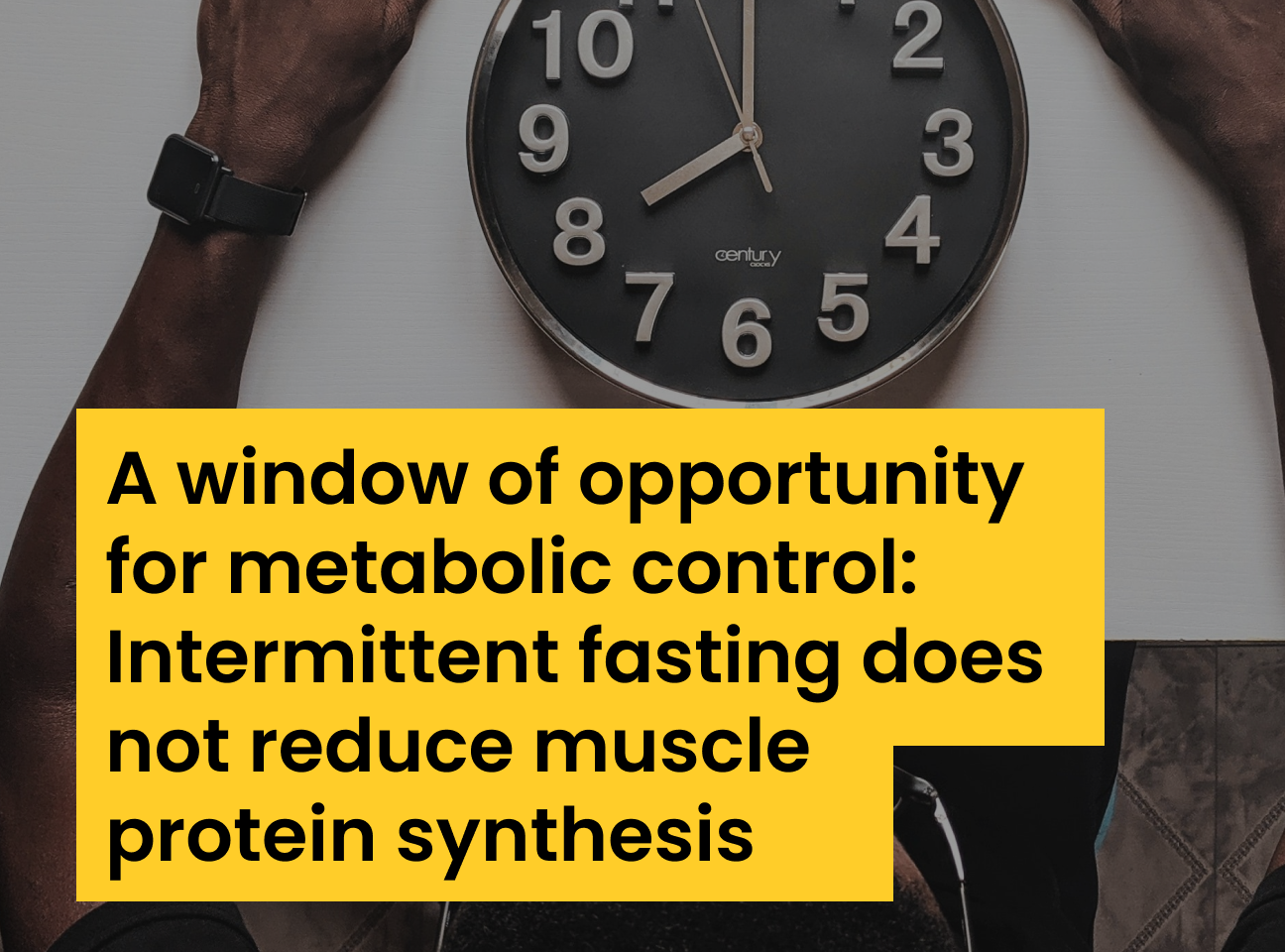
A window of opportunity for metabolic control: Intermittent fasting does not reduce muscle protein synthesis
By Dr. Mark Hearris

Research: Eight‐hour time‐restricted eating does not lower daily myofibrillar protein synthesis rates: A randomized control trial by Parr et al (2023) (open access)
Context: Time-restricted eating (also known as intermittent fasting) is a commonly used “dieting” strategy whereby the opportunity to consume food or drink is reduced from anywhere between four to eight hours each day. For example, a four-hour eating window may begin at noon and end at 4:00 p.m., with the remainder of the day spent fasting. This strategy is based on the premise that simply reducing the opportunity to eat reduces the overall energy (kCal) we consume throughout the day, providing an intuitive dieting strategy for those who don’t wish to count calories. Not only does time-restricted eating result in weight loss, it also appears to improve various markers of glucose control when compared with standard energy restricted diets (Che et al., 2021). Whilst promising, the nature of a reduced feeding window has led some researchers to suggest that rates of muscle protein synthesis (MPS) may be compromised as it becomes more difficult to distribute protein intake across the day evenly – a strategy that appears to be important for repeatedly stimulating MPS (Areta et al., 2013). If this is the case, it may be that the positive effects of time restricted eating on glucose control are offset by losses in skeletal muscle mass if performed for prolonged periods of time.
The study: 18 male participants who were classified as either overweight or obese (average BMI of 30 ± 2 km/m2) were randomly split into one of two groups where they would follow a calorie-controlled diet (containing 1 g.kg-1 BM of protein) for ten days. One of the groups (time-restricted feeding group) was required to consume all daily food and drink within an 8-hour window (10:00 am to 6:00 pm; mealtimes at 10:00 am, 2:00 pm and 6:00 pm), whereas the other group had an extended eating window from 8:00 am to 8:00 pm (mealtimes at 8:00 am, 2:00 pm and 8:00 pm). MPS rates were measured using deuterium oxide (heavy water) combined with muscle biopsy samples taken at baseline and after the 10 day intervention period. Importantly, participants were provided with an energy intake equivalent to their estimated daily energy expenditure (e.g., energy balance) and were asked to not perform any structured strenuous exercise training.
A closer look: Measuring MPS with deuterium oxide:
Typically, most studies that measure acute MPS responses to either exercise or feeding use specific amino acid isotopes (usually leucine or phenylalanine) which require invasive intravenous infusions under laboratory-controlled conditions which only provide a limited snapshot inside the muscle for several hours. In contrast, the use of deuterium oxide (also known as heavy water) provides a more holistic assessment of MPS over days, weeks or even months which is more suitable for skeletal muscle proteins that are slowly synthesised and provides a better proxy marker of long-term muscle hypertrophy (Brook et al., 2015). Consider heavy water to have small tags (labels) on the hydrogen molecules that make it distinguishable from our body water – once we drink the heavy water it equilibrates with our body water and gives us what is known as a labelled precursor pool which is essentially a pool of “tagged” hydrogen molecules. Over time, the tagged deuterium becomes incorporated into amino acids which are used for MPS and allow for the enrichment of the label (e.g. how many tags are present in the muscle) to be calculated from a biopsy sample of the muscle of interest.
Findings: As opposed to other studies that measure acute MPS responses, which only provide a short snapshot inside the muscle, the use of deuterium oxide in this study allows MPS rates to be calculated across the entire 10 day period. Using this method, the data from this study show that reducing the feeding window down to 8 hours had no detrimental impact on MPS compared with the longer 12-hour window. Despite the lack of changes in MPS, time restricted eating did result in a small yet significant loss of total lean mass (~ 1.0 kg) when compared with the control group, although this may simply reflect changes in fluid, organ or digestive system mass given that no loss of lean mass was detected in any of the limbs (e.g., loss of lean mass was from the trunk only). In relation to glucose metabolism, time-restricted eating also resulted in improved glucose control when compared with the control group, who showed reduced glucose concentrations across each 24-h hour period as well as reduced peak glucose concentrations after consuming both lunch and dinner.
Relevance: Time restricted eating within a reduced “feeding window” leads to improvements in glucose control in as little as ten days without any detrimental effects on muscle health. Whilst the results of the present study are promising, the impact of time restricted feeding during periods of dieting (where this strategy is commonly applied) are still unknown. This is particularly important given that periods of energy deficit have been shown to reduce rates of MPS and, in some cases, the loss of skeletal muscle mass. Furthermore, the use of overweight or obese (yet otherwise healthy) subjects reduces the applicability of these data to trained groups and athletes where the loss of muscle mass may be more likely given the reduced proportions of fat-mass in these individuals. Finally, given that exercise increases the turnover of muscle protein, it is also unknown whether these results would hold true in scenarios where participants are performing regular exercise. Nonetheless, these data still provide an important piece to the puzzle and lead the way for future research to answer some of the above questions that will likely help practitioners to make an informed decision on the usefulness of time restricted eating with their clients. For now, practitioners wishing to adopt this strategy should carefully consider providing sufficient protein that is evenly distributed throughout the feeding window — something that is likely to become more important in scenarios where the feeding window is particularly short (e.g. 6 hours).
Recommended listening:Complement this research with the We Do Science podcast episode: Time Restricted Eating and Exercise with Dr. Evelyn Parr
References
Areta, J. L., Burke, L. M., Ross, M. L., Camera, D. M., West, D. W., Broad, E. M., Jeacocke, N. A., Moore, D. R., Stellingwerff, T., Phillips, S. M., Hawley, J. A., & Coffey, V. G. (2013). Timing and distribution of protein ingestion during prolonged recovery from resistance exercise alters myofibrillar protein synthesis. J Physiol, 591(9), 2319-2331. https://doi.org/10.1113/jphysiol.2012.244897
Brook, M. S., Wilkinson, D. J., Mitchell, W. K., Lund, J. N., Szewczyk, N. J., Greenhaff, P. L., Smith, K., & Atherton, P. J. (2015). Skeletal muscle hypertrophy adaptations predominate in the early stages of resistance exercise training, matching deuterium oxide-derived measures of muscle protein synthesis and mechanistic target of rapamycin complex 1 signaling. FASEB J, 29(11), 4485-4496. https://doi.org/10.1096/fj.15-273755
Che, T., Yan, C., Tian, D., Zhang, X., Liu, X., & Wu, Z. (2021). Time-restricted feeding improves blood glucose and insulin sensitivity in overweight patients with type 2 diabetes: a randomised controlled trial. Nutr Metab (Lond), 18(1), 88. https://doi.org/10.1186/s12986-021-00613-9
